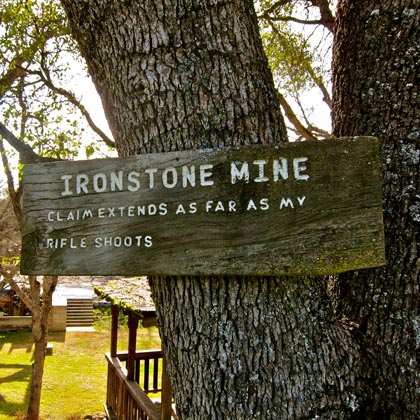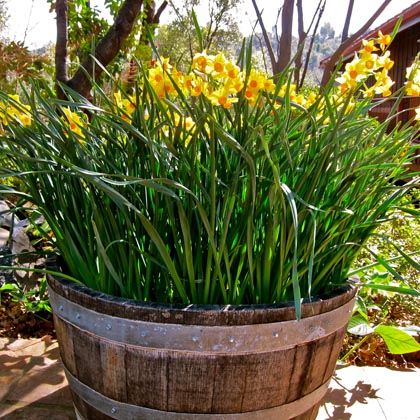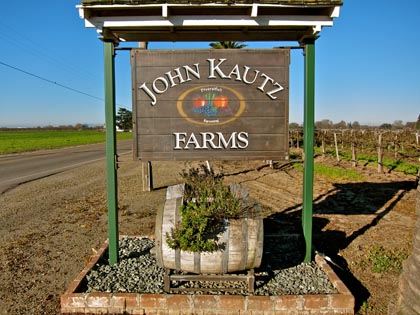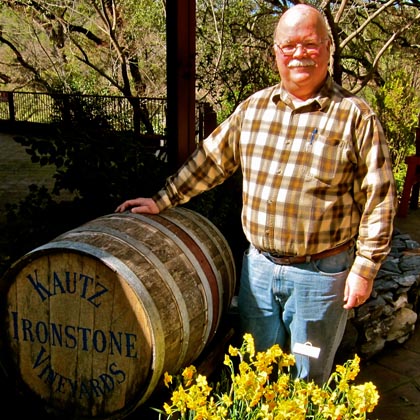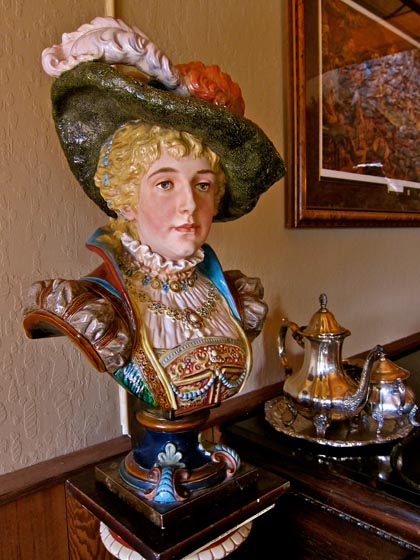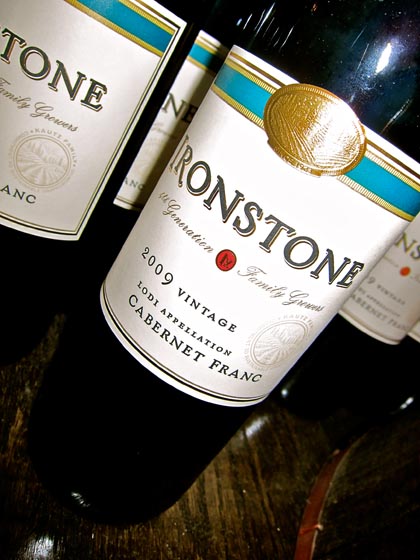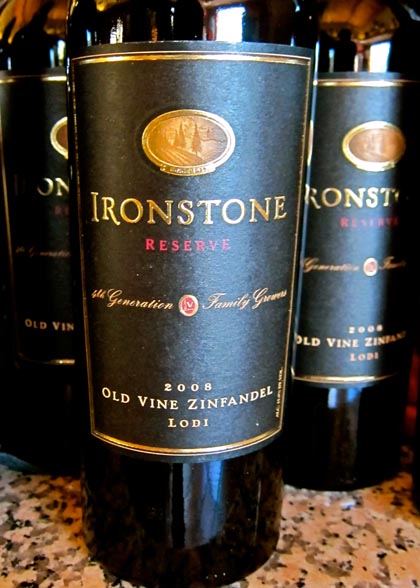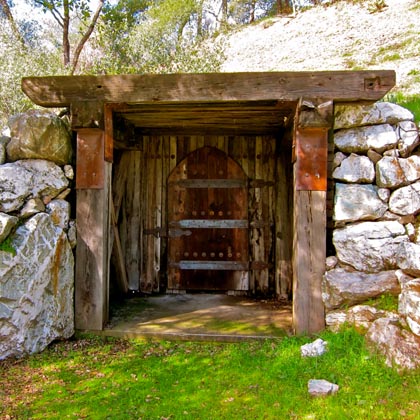Letters from Lodi
An insightful and objective look at viticulture and winemaking from the Lodi
Appellation and the growers and vintners behind these crafts. Told from the
perspective of multi-award winning wine journalist, Randy Caparoso.
The wave of the future in Ironstone’s past
Good ol' Mother Lode country hospitality
The Kautz Family’s Ironstone Vineyards continues to lead Lodi into the future…
Why pay more for a perfectly delicious bottle of wine than you have to? Part and parcel of Lodi’s dramatic emergence as an ultra-premium quality winegrowing region since the turn of the millennium has been the fulfillment of that question. Today Lodi wines not only deliver quality, they overdeliver for the price; and it all starts in the vineyard…
Fact #1: Lodi is California’s single largest producer of Vitis vinifera — grapes belonging to the European family of classic wine grapes — simply because these grapes thrive in the AVA‘s rich soils and moderate Delta climate (the latter factor, pretty much on the par with the climate found in mid-Napa Valley and most of Sonoma County).
Fact #2: While the ease of growing Vitis vinifera has resulted in Lodi’s past reputation primarily as the source of many of California’s lower priced wines, these very same ideal growing conditions are also the reasons why more and more of the state’s finest wines have recently been coming out of Lodi — the region’s Mediterranean terroir just as conducive to growing wine grapes for quality as it is for quantity.
Fact #3: Because many of Lodi’s winegrowing families first established themselves anywhere from 50 to over 100 years ago — growers in their third, fourth, fifth or even sixth generation are a norm in Lodi, unlike anywhere else in the U.S. — ultra-premium quality wines from Lodi typically do not come with prices reflecting start-up, or replanting, costs typical of wines from, say, Napa Valley or Sonoma County.
… and that’s just the way it is: especially for Ironstone Vineyards, a Sierra Foothills (Murphys, Calaveras County) winery founded in 1988 by longtime Lodi grapegrower, John Kautz.
The Kautz family originally arrived in Lodi in the 1920s, and it was in 1948 when John Kautz first augmented the family’s row crops and orchards with 12 acres of wine grapes on the eastern side of Lodi. In no time Kautz Family Vineyards’ Lodi plantings grew to 5,500 acres, followed by another 1,300 acres of vines, cattle ranch, and (eventually) winery property in the Foothills, on land originally owned by the grandfather of Gail Kautz, John’s wife. Today Kautz stands as California’s tenth largest grower of wine grapes; much of that success attributable to pure skill, business acumen, and old fashioned horse sense: through the years, Kautz consistently found himself in the driver’s seat, having aggressively planted grapes like Chardonnay and Merlot well ahead of booming consumer demand throughout the sixties, seventies and eighties.
For successful winegrowers, life is more than just a box of chocolates: it pays to know, well ahead of time, what’s in each one.
Steve Millier, Ironstone's crafty Director of Winemaking
… and typical of Lodi’s adept growers, the vast majority of Kautz’s grapes ends up in wines bottled by numerous other California wineries (there’s traditionally been a lot of good Lodi fruit in “Napa Valley” and “Sonoma” wines), while a small percentage of the finest grapes are cherry picked for the Kautz family’s Ironstone label.
Fact #4: For sheer, joyous purity of varietal fruit definition, not to mention deliciousness, it’s hard to beat Ironstone’s Lodi sourced, $10-$12 bottlings of Chardonnay, Merlot, Cabernet Franc, Syrah, and Old Vine Zinfandel — few wineries, from anywhere on the West Coast, matching Ironstone’s consistency of quality across the board!
This past week we took the hour and a half drive through the green, rolling lower Foothills between Lodi and Murphys to meet up with Steve Millier, Ironstone’s crafty V.P. and Director of Winemaking. Millier has been working with Mr. Kautz and his son Steven Kautz ever since the winery’s “wine caverns” were dynamited, pick axed and shoveled out from solid limestone rock — in good ol’ fashioned Mother Lode style — in 1989 (since then, a beautifully dramatic, seven story winery, visitors center and museum have been erected over those caverns, wowing legions of intrepid wine lovers during visiting hours, Wednesdays through Sundays).
Our tasting notes, along with some of Mr. Millier’s insights:
2008 Ironstone, California Chardonnay ($10-$12) – Although this wine carries a California, rather than Lodi, appellation, 100% of the grapes in this wine are grown in the Kautzs’ Lodi vineyards, and Millier takes pains to vinify it as a pure expression of “fruitfulness” — in fact, deliberately in a return to the styles of the sixties and seventies, when everything seemed innocent or groovy — sans the oak, excess alcohol or other distractions that typically weigh down the majority of Chardonnays made today. Sweet apple, lemon/citrus, and fresh leafy green fragrances are pervasive in the nose; and the taste is crisply dry (don’t look here for soft, mushy tutti-fruitiness), lightly tart, taut, trim and silky in the middle, like a Reese Witherspoon with abs of steel.
2009 Ironstone, California Merlot ($10-$12) – The film Sideways, Millier sighs almost longingly, “took a bite out of Merlot’s popularity,” and we can feel his pain: this bottling, almost 100% Lodi grown, tastes like the red wine of every Merlot lover’s original dream: plump, round, bouncy, juicy rich and mouthwatering; teeming with the lush black cherry qualities of the grape, without being flabby, heavy, insolent or supercilious. A naive, domestic burgundy, perhaps, but as kissable as any ever made, notwithstanding the outrageously decent bill of fare. If you miss this kind of vinous ardor, perhaps it’s time to come back to this genuinely compelling grape — at least, this one by Ironstone!
2009 Ironstone, Lodi Cabernet Franc ($10-$12) – This is where the Kautz family and Millier really show their chops. Mr. Kautz didn’t waste a second, Millier tells us, “when he returned from a trip to Bordeaux in 1989 and told us to plant this grape… immediately!” 130 acres of Cabernet Franc went into the ground that same year: significantly, the largest single commitment to this Bordeaux variety in the entire state. Today’s happy ending: you would be hard pressed to find a varietal Cabernet Franc as fine, floral and focused as this one. The nose is perfumed with the raspberry and mild peppermint spice characterizing the best side of this grape; without a hint of the herbal or bell peppery notes that have plagued Cabernet Francs grown elsewhere in California (and also not uncommon in Cabernet Franc based reds from France’s Loire River region). Instead, Ironstone’s is fresh and flush with red faced fruit; soft and opulent like a good Merlot, but more slender and sleeker than typical Merlot (think Natalie Portman compared to Christina Ricci). Oh, you cannot, should not ignore this Ironstone specialty…
2009 Ironstone, Lodi Syrah ($10-$12) – Like Merlot, this grape has been recently maligned; and when you taste Ironstone’s, you truly wonder why many consumers have gone away from it. You cannot, after all, blame the Kautz family for the way the Australians began to bastardize the grape with their cheap and trampy hoards of “Shiraz” that once dominated supermarket wine sales. The Kautzs lavish as much care on their Lodi grown Syrah as ever; and you taste that in this bottling, pristinely pretty, almost clamorous in its nakedness and intricacy: brightly floral fragrances suggesting violets, a twist of black pepper, dark plums, a smidgen of raspberry, and pungent touches of fennel and sweet kitchen spices. On the palate, just medium-full, curvy and spiced, with nary a rough or discouraging edge.
2009 Ironstone, Lodi Old Vine Zinfandel ($10-$12) – “We’ve never gone for the jammy, alcoholic or oaky style of Zinfandel, even when that became the popular style in Lodi,” Millier tells us. Okay. Is this the biggest and richest of Zinfandels? No, it isn’t. Does it taste like Lodi grown Zinfandel? Absolutely, positively, indubitably, yes… how else to you define this wine’s bright, blushing fruit qualities, bursting with strawberry preserves (not an overripe, or cooked, jamminess) tinged with juicy black cherry and cinnamon stick spice fragrances? Ah, Lodi fruit! On the palate, a Zinfandel of medium weight and soft tannin, yet sturdy and zesty through a lilting finish. If you’ve never been a zin lover easily impressed by size or oak embellishments, you’re going to be a happy camper with this bottling, forged primarily from vines averaging 40 to 50 years of age.
2008 Ironstone, Lodi Reserve Zinfandel ($22-$25) – For this bottling, from vines averaging 70-80 years of age, Millier applies a slightly more aggressive barrel aging program; yet, like all the Ironstone wines, the predominant aromatic notes are of fruit — here, wild strawberry mixed with blackberry, dense and intense enough to give black chocolaty impressions — and the focus on the palate is on varietal fruit flavor rather than excess of tannin from either fruit or wood. There’s a thicker, more velvety flow of these fruit forward qualities in the Reserve, compared to Ironstone’s lower priced zin bottling, while being no less lovely, and unabashedly feminine, in its seduction of curves.
Fact #5: What’s not to love in Ironstone’s downright obsessive compulsion towards purer, unmucked expressions of Lodi “fruitfulness?” If the history of the Kautz family’s past success tells us anything, this is more likely to be Lodi’s wave of the future, not of its past.
